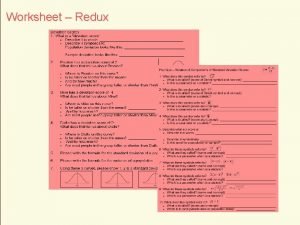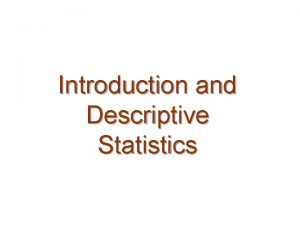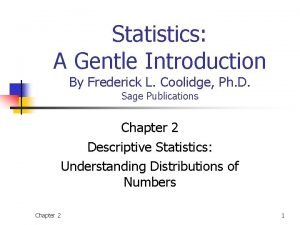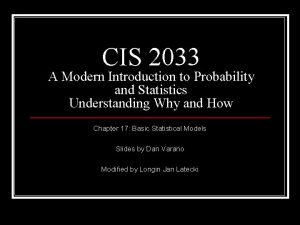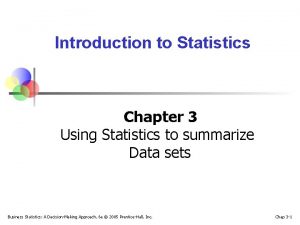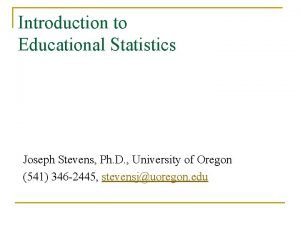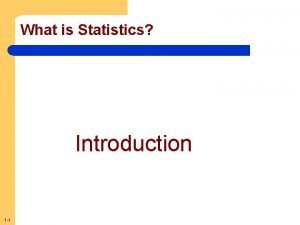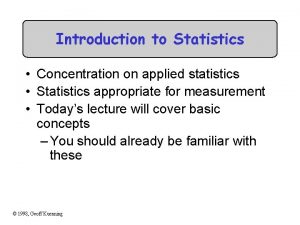What is Statistics Introduction 1 1 What is
















- Slides: 16

What is Statistics? Introduction 1 -1

What is Meant by Statistics? In the more common usage, statistics refers to numerical information l Examples: the average starting salary of college graduates, the number of deaths due to alcoholism last year, the change in the Dow Jones Industrial Average from yesterday to today, and the number of home runs hit by the Chicago Cubs during the 2007 season. 1 -2

Formal Definition of Statistics STATISTICS The science of collecting, organizing, presenting, analyzing, and interpreting data to assist in making more effective decisions. Some examples of the need for data collection. l l l 1 -3 The marketing department at Colgate-Palmolive Co. , a manufacturer of soap products, has the responsibility of making recommendations regarding the potential profitability of a newly developed group of face soaps having fruit smells. The United States government is concerned with the present condition of our economy and with predicting future economic trends. Managers must make decisions about the quality of their product or service.

Who Uses Statistics? Statistical techniques are used extensively by marketing, accounting, quality control, consumers, professional sports people, hospital administrators, educators, politicians, physicians, etc. . . 1 -4

Types of Statistics – Descriptive Statistics and Inferential Statistics Descriptive Statistics - methods of organizing, summarizing, and presenting data in an informative way. EXAMPLE 1: The United States government reports the population of the United States was 179, 323, 000 in 1960; 203, 302, 000 in 1970; 226, 542, 000 in 1980; 248, 709, 000 in 1990, and 265, 000 in 2000. EXAMPLE 2: According to the Bureau of Labor Statistics, the average hourly earnings of production workers was $17. 90 for April 2008. 1 -5

Types of Statistics – Descriptive Statistics and Inferential Statistics: A decision, estimate, prediction, or generalization about a population, based on a sample. Note: In statistics the word population and sample have a broader meaning. A population or sample may consist of individuals or objects 1 -6

Summary of Types of Variables 1 -7

Types of Variables A. Qualitative or Attribute variable - the characteristic being studied is nonnumeric. EXAMPLES: Gender, religious affiliation, type of automobile owned, state of birth, eye color are examples. B. Quantitative variable - information is reported numerically. EXAMPLES: balance in your checking account, minutes remaining in class, or number of children in a family. 1 -8

Quantitative Variables - Classifications Quantitative variables can be classified as either discrete or continuous. A. Discrete variables: can only assume certain values and there are usually “gaps” between values. EXAMPLE: the number of bedrooms in a house, or the number of hammers sold at the local Home Depot (1, 2, 3, …, etc). B. Continuous variable can assume any value within a specified range. EXAMPLE: The pressure in a tire, the weight of a pork chop, or the height of students in a class. 1 -9

Four Levels of Measurement Nominal level - data that is classified into categories and cannot be arranged in any particular order. EXAMPLES: eye color, gender, religious affiliation. Ordinal level – data arranged in some order, but the differences between data values cannot be determined or are meaningless. EXAMPLE: During a taste test of 4 soft drinks, Mellow Yellow was ranked number 1, Sprite number 2, Seven-up number 3, and Orange Crush number 4. 1 -10 Interval level - similar to the ordinal level, with the additional property that meaningful amounts of differences between data values can be determined. There is no natural zero point. EXAMPLE: Temperature on the Fahrenheit scale. Ratio level - the interval level with an inherent zero starting point. Differences and ratios are meaningful for this level of measurement. EXAMPLES: Monthly income of surgeons, or distance traveled by manufacturer’s representatives per month.

Nominal-Level Data Properties: 1. Observations of a qualitative variable can only be classified and counted. 2. There is no particular order to the labels. 1 -11

Ordinal-Level Data Properties: 1. 2. 1 -12 Data classifications are represented by sets of labels or names (high, medium, low) that have relative values. Because of the relative values, the data classified can be ranked or ordered.

Interval-Level Data Properties: 1. 2. Data classifications are ordered according to the amount of the characteristic they possess. Equal differences in the characteristic are represented by equal differences in the measurements. (Example: Likert Scale) Example 2: Women’s dress sizes listed on the table. 1 -13

Ratio-Level Data l l Practically all quantitative data is recorded on the ratio level of measurement. Ratio level is the “highest” level of measurement. Properties: 1. 2. 3. 1 -14 Data classifications are ordered according to the amount of the characteristics they possess. Equal differences in the characteristic are represented by equal differences in the numbers assigned to the classifications. The zero point is the absence of the characteristic and the ratio between two numbers is meaningful.

Why Know the Level of Measurement of a Data? l l 1 -15 The level of measurement of the data dictates the calculations that can be done to summarize and present the data. To determine the statistical tests that should be performed on the data

Summary of the Characteristics for Levels of Measurement 1 -16
 Introduction to statistics what is statistics
Introduction to statistics what is statistics Introduction to statistics worksheet
Introduction to statistics worksheet Introduction to statistics and some basic concepts
Introduction to statistics and some basic concepts Introduction to descriptive statistics
Introduction to descriptive statistics Chapter 1 introduction to statistics
Chapter 1 introduction to statistics Introduction to bayesian statistics
Introduction to bayesian statistics Introduction to elementary statistics
Introduction to elementary statistics Statistics a gentle introduction
Statistics a gentle introduction A modern introduction to probability and statistics
A modern introduction to probability and statistics Chapter 1 introduction to statistics
Chapter 1 introduction to statistics Introduction to statistics in ap biology
Introduction to statistics in ap biology Introduction to statistics chapter 3 answers
Introduction to statistics chapter 3 answers Introduction to educational statistics
Introduction to educational statistics Intro paragraph outline
Intro paragraph outline Level of measurement statistics
Level of measurement statistics National forum on education statistics
National forum on education statistics Define mean average
Define mean average

